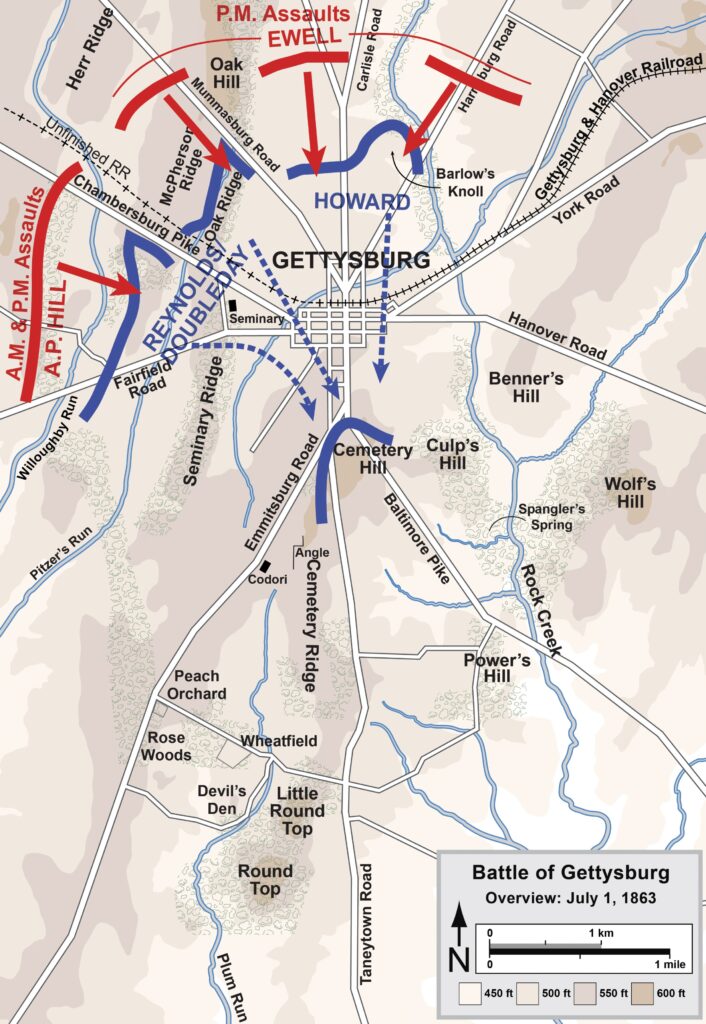The Battle of Gettysburg Day 1 began in the early morning hours of July 1, 1863, to the west of Gettysburg, Pennsylvania.
Two Union Cavalry Brigades under Brigadier General John Buford, who had arrived in Gettysburg the day before, spotted Confederate divisions approaching the town from the west up Chambersburg Pike.
Jump to:
Battle of Gettysburg Day 1: General Buford's Stand
In an effort to protect the high ground, Buford hastily formed defensive lines along Herr Ridge, McPherson Ridge, and Seminary Ridge just west of Gettysburg.
General Buford intended for this defense to be merely a delaying action to keep the Confederate forces at bay until the Union infantry could reinforce and occupy the heights south of town. The Battle of Gettysburg was officially underway.
Confederate Major General Henry Heath was the first to engage with Buford's cavalry at 7:30 a.m., and at first, he expected minimal resistance.
He sent two divisions under Brigadier General James J. Archer and Joseph R. Davis ahead to occupy the town, and they were surprised to find such fierce resistance.
Heavy fighting ensued, and Buford's cavalry defended admirably against larger numbers.
General Buford was able to hold out for a few hours until he was reinforced by Brigadier General Lysander Cutler and Solomon Meredith under Major General John F. Reynold's I Corps.
Battle of Gettysburg Day 1: Reinforcements
The divisions under Archer and Davis again attacked the Union line, intent on breaking through the cavalry defenses.
They did not realize, however, that the Union lines had been reinforced, and they incurred heavy casualties.
At approximately 10:30 a.m., as General John Reynolds was organizing the Iron Brigade into defensive positions, he was knocked from his horse after being struck by a bullet behind his right ear and was killed instantly.
Although his battlefield experience was somewhat limited compared to others, he was considered by many to be the best officer in the Union Army.
Major General Abner Doubleday, being the ranking officer, assumed command of the Union defenses on Gettysburg day 1 and was immediately tested by frontal assaults from the Confederates.

Battle of Gettysburg Day 1: General Ewell's Attack from the North
North of town, Confederate Lt. General Richard S. Ewell's Second Corps, which had marched west through Cashtown, took a turn south to engage at Gettysburg.
His assault down the Harrisburg and Carlisle Roads forced the Union defenses to react on Gettysburg day 1.
Major General Oliver O. Howard was rushed forward from the south of town, traveling up the Baltimore Pike and Taneytown Road in a northerly direction.
The Union Army did not have enough troops, however, to defend against the Confederate assaults from the west, north, and northeast of Gettysburg and hastily brought reinforcements forward when needed to maintain the lines.
Commander of the Confederate Army of Virginia, General Robert E. Lee, arrived on the scene at approximately 2:30 p.m. and ordered Lt. General A.P. Hill to join Ewell's assault. Hill sent Brigadier General J. Johnston Pettigrew to attack Union brigades positioned on McPherson Ridge.
They were able to flank and drive back segments of the Union line, including Meredith's Iron Brigade, through the woods toward Seminary Ridge.
The Iron Brigade attempted to make a desperate stand by the Seminary but was instead pushed back off the ridges west of town and through the streets of Gettysburg.
Meanwhile, Confederate Major General Robert E. Rhodes and Jubal Early mounted assaults against Union positions on the north and northwest of town. Early was able to capitalize on a salient created by Union Brigadier General Francis C. Barlow when he advanced XI Corps too far forward.
Barlow was in a compromising position when he was attacked on all sides, and considering his Corps was the right flank of the Union position, it put the rest of the Federal units in serious jeopardy.
Barlow himself was captured and left for dead as his men retreated, and the Union lines both north and west of town began breaking apart from the relentless pressure of the Confederates.
Battle of Gettysburg Day 1: Union Retreat
Finally, Union Major General Oliver O. Howard ordered a retreat of all units to defensive positions just south of town on Cemetery Hill on Gettysburg day 1.
Here, Major General Winfield S. Hancock assumed command of the Union forces from Major General Abner Doubleday.
This was at the request of Union Major General George Gordon Meade upon hearing that Reynolds was killed. Howard and Hancock both agreed that their current position was an excellent one for a major battle, so they formed defensive lines there with infantry and artillery.
On the Confederate side, General Lee studied the situation and gave the decision to General Ewell to attack the Union positions "if practicable."
Ewell made the decision not to attack, perhaps due to the heavy losses suffered by the Confederates, and this concluded the fighting at Gettysburg on day 1.
